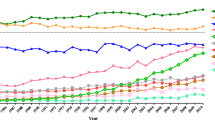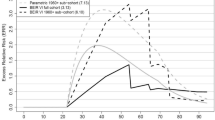Abstract
Background
Three industrial waste incinerators (IWIs) were built in 1999, 2001, and 2010, within a 3 km radius of a town with a population of around 5000 in Korea. This study evaluated whether residents near these three IWIs had increased cancer incidence than those from other areas in Korea using regional health data.
Methods
Standardized incidence ratios (SIR) were calculated using the frequency of cancer cases in the National Cancer Registry of the exposed area (Buki-myeon), Chungcheongbuk-do (Chungbuk, state including Buki-myeon), and whole Korea from 1999 to 2017. A retrospective cohort was created using National Health Insurance System data from 2002 to 2018. The exposed group was defined as those having a residential history in the exposed area. The control group was defined as those having a residential history in nearby towns or counties in Chungbuk, excluding counties having living and cultural areas in other provinces and cities. Hazard ratio (HR) and 95% confidence intervals (CI) were estimated using the Cox proportional hazard model adjusted for age, level of health insurance fee, and smoking history.
Results
In the ecological study using National Cancer Registry data, the risk of all cancers, all cancers excluding thyroid, esophageal, stomach, and lung cancers in the exposed area were 1.13 (95% CI 1.03–1.24), 1.15 (95% CI 1.04–1.26), 1.91 (95% CI 1.13–2.89), 1.39 (95% CI 1.14–1.66), and 1.29 (95% CI 1.03–1.57) times higher than in whole Korea among exposed males, respectively. In the retrospective cohort, 4300 males (26,821 person-years) and 3796 females (24,746 person-years) in exposed group, 150,964 males (1,212,010 person-years) and 134,535 females (1,104,025 person-years) in control group were analyzed. After adjusting for several confounding factors, the risks for gallbladder cancer among males and kidney cancer among females were 2.65 (95% CI 1.38–5.06) and 2.82 (95% CI 1.13–7.03) times higher in the exposed group versus the control group, respectively.
Conclusions
Cancer risk was higher in Koreans having residential history living near IWIs compared to the other areas. Further study warrants nationwide effects and longer follow-up of WIs for cancers in Korea.




Similar content being viewed by others
Availability of data and materials
Data are available from the Korean National Cancer Control Institute (KNCCI) and the Korean National Health Insurance System (KNHIS). However, the data cannot be shared publicly because KNCCI and KNHIS do not allow researchers to provide data personally or share it publicly. No researcher is permitted to export raw data from KNHIS.
Abbreviations
- AAPC:
-
Average annual percent change
- APC:
-
Annual percent change
- ASR:
-
Age-standardized incidence rate
- CI:
-
Confidence interval
- DB:
-
Database
- HR:
-
Hazard ratio
- IARC:
-
International Agency Research on Cancer
- ICD-10 code:
-
International classification of diseases, 10th revision
- IWI:
-
Industrial waste incinerator
- KNCCI:
-
Korean National Cancer Control Institute
- KNHIS:
-
Korean National Health Insurance System
- KOSIS:
-
Korean Statistical Information Service
- PCB:
-
Polychlorinated biphenyls
- PCDD/F:
-
Polychlorinated dibenzo-p-dioxins and furans
- PIN:
-
Personal Identification Number
- POP:
-
Persistent organic pollutants
- SIR:
-
Standardized incidence ratio
- TCDD:
-
2378-Tetrachlorodibenzo-p-dioxin
- TSP:
-
Total suspended particles
- WI:
-
Waste incinerator
References
Ashworth DC, Fuller GW, Toledano MB, Font A, Elliott P, Hansell AL et al (2013) Comparative assessment of particulate air pollution exposure from municipal solid waste incinerator emissions. J Environ Public Health 2013:560342
Boyle P, Parkin DM (1991) Statistical methods for registries. Cancer registration: principles and methods. International Agency for Research on Cancer, Lyon
Choi Y-S, Ochirpurev B, Chae H-Y, Eom S-Y, Kim Y-D, Kim H (2021) Health risk related to waste incineration. Journal of Environmental Health Sciences. 47:20–35. https://doi.org/10.5668/JEHS.2021.47.1.20 (In Korean. Abstract in English)
Comba P, Ascoli V, Belli S, Benedetti M, Gatti L, Ricci P et al (2003) Risk of soft tissue sarcomas and residence in the neighbourhood of an incinerator of industrial wastes. Occup Environ Med 60:680–683
Domingo JL, Marquès M, Mari M, Schuhmacher M (2020) Adverse health effects for populations living near waste incinerators with special attention to hazardous waste incinerators. A review of the scientific literature. Environ Res 187:109631
Elliott P, Hills M, Beresford J, Kleinschmidt I, Jolley D, Pattenden S et al (1992) Incidence of cancers of the larynx and lung near incinerators of waste solvents and oils in Great Britain. Lancet 339:854–858
Federico M, Pirani M, Rashid I, Caranci N, Cirilli C (2010) Cancer incidence in people with residential exposure to a municipal waste incinerator: an ecological study in Modena (Italy), 1991–2005. Waste Manag 30:1362–1370
Floret N, Mauny F, Challier B, Arveux P, Cahn J-Y, Viel J-F (2003) Dioxin emissions from a solid waste incinerator and risk of non-Hodgkin lymphoma. Epidemiology 14:392–398
Fukuda Y, Nakamura K, Takano T (2003) Dioxins released from incineration plants and mortality from major diseases: an analysis of statistical data by municipalities. J Med Dent Sci 50:249–255
IARC (2012) IARC Monographs on the Evaluation of Carcinogenic Risks to Humans. Lyon, France: International Agency for Research on Cancer
Kim H (2021) Pilot study of monitoring of health effects among residents living near area with potentially severe environmental pollution. Sejong: Ministry of Environ
Kim Y, Yang SH, Kim M, Shin DC (2001) PCDD and PCDF exposures in workers and controls living near an industrial waste incinerator. Chemosphere 43:985–987
Kim BH, Lee SJ, Mun SJ, Chang YS (2005a) A case study of dioxin monitoring in and around an industrial waste incinerator in Korea. Chemosphere 58:1589–1599
Kim BH, Ikonomou MG, Lee SJ, Kim HS, Chang YS (2005b) Concentrations of polybrominated diphenyl ethers, polychlorinated dibenzo-p-dioxins and dibenzofurans, and polychlorinated biphenyls in human blood samples from Korea. Sci Total Environ 336:45–56
Kim YM, Kim JW, Lee HJ (2011) Burden of disease attributable to air pollutants from municipal solid waste incinerators in Seoul, Korea: a source-specific approach for environmental burden of disease. Sci Total Environ 409:2019–2028
Knerr S, Schrenk D (2006) Carcinogenicity of 2,3,7,8-tetrachlorodibenzo-p-dioxin in experimental models. Mol Nutr Food Res 50:897–907
Knox E (2000) Childhood cancers, birthplaces, incinerators and landfill sites. Int J Epidemiol 29:391–397
Korean Law Information Center (2021) PERSISTENT ORGANIC POLLUTANTS CONTROL ACT. Environment Mo. Act No.895. 3. 7. Available from: https://www.law.go.kr/LSW//lsSc.do?section=&menuId=1&subMenuId=15&tabMenuId=81&eventGubun=060101&query=%EC%9E%94%EB%A5%98%EC%84%B1%EC%9C%A0%EA%B8%B0%EC%98%A4%EC%97%BC%EB%AC%BC%EC%A7%88+%EB%B0%B0%EC%B6%9C%ED%97%88%EC%9A%A9%EA%B8%B0%EC%A4%80%28%EC%A0%9C7%EC%A1%B0+%EA%B4%80%EB%A0%A8%29#undefined
Korean National Cancer Center (2022) Organization of National Cancer Control Institute. Available from: http://www.ncc.re.kr/main.ncc?uri=english/sub04_Organization.
Korean Statistical Information Service (KOSIS) [Internet] (2022) Available from: http://kosis.kr/eng/.
Mariné Barjoan E, Doulet N, Chaarana A, Festraëts J, Viot A, Ambrosetti D et al (2020) Cancer incidence in the vicinity of a waste incineration plant in the Nice area between 2005 and 2014. Environ Res 188:109681
Ministry of Environment (2000). National Waste Generation and Treatment Status. Gwacheon: Minitry of Environment, 2001 Contract No.: 11-1480000-000533-10
Ministry of Environment (2003) Dioxin measurement results from waste incineration facilities exceeding emission standards for some facilities. Ministry of Environment. Available from: http://me.go.kr/home/web/board/read.do?pagerOffset=9280&maxPageItems=10&maxIndexPages=10&searchKey=&searchValue=&menuId=&orgCd=&boardMasterId=1&boardCategoryId=&boardId=82946&decorator=
Ministry of Environment, Korea Environment Corporation (2010) National Waste Generation and Treatment Status. Incheon: Ministry of Environment, Korea Environment Corporation, 2011 Contract No.: 11-B552584-000005-10
Ministry of Environment, Korea Environment Corporation (2019) National Waste Generation and Treatment Status. Incheon: Ministry of Environment, Korea Environment Corporation, 2020 Contract No.: 11-1480000-001552-10
Moon CS, Chang YS, Kim BH, Shin D, Ikeda M (2005) Evaluation of serum dioxin congeners among residents near continuously burning municipal solid waste incinerators in Korea. Int Arch Occup Environ Health 78:205–210
National Cancer Institute (2020) Joinpoint Regression Program. Version 4.8.0.1. Calverton, MD, USA: Statistical Research and Application Branch, National Cancer Institute, USA, Available from: https://surveillance.cancer.gov/joinpoint/
Negri E, Bravi F, Catalani S, Guercio V, Metruccio F, Moretto A et al (2020) Health effects of living near an incinerator: a systematic review of epidemiological studies, with focus on last generation plants. Environ Res 184:109305
Park S, Kim SJ, Kim KS, Lee DS, Kim JG (2004) Influence of an industrial waste incinerator as assessed by the levels and congener patterns of polychlorinated dibenzo-p-dioxins and polychlorinated dibenzofurans. Environ Sci Technol 38:3820–3826
Park H, Ikonomou MG, Kim HS, Choi JW, Chang YS (2009) Dioxin and dioxin-like PCB profiles in the serum of industrial and municipal waste incinerator workers in Korea. Environ Int 35:580–587
Park H, Park E, Chang YS (2014) Ten-year time trend of dioxins in human serum obtained from metropolitan populations in Seoul, Korea. Sci Total Environ 470–471:1338–1345
Park S, Oh CM, Cho H, Lee JY, Jung KW, Jun JK et al (2016) Association between screening and the thyroid cancer “epidemic” in South Korea: evidence from a nationwide study. BMJ 355:i5745
Parodi S, Baldi R, Benco C, Franchini M, Garrone E, Vercelli M et al (2004) Lung cancer mortality in a district of La Spezia (Italy) exposed to air pollution from industrial plants. Tumori 90:181–185
Ranzi A, Fano V, Erspamer L, Lauriola P, Perucci CA, Forastiere F (2011) Mortality and morbidity among people living close to incinerators: a cohort study based on dispersion modeling for exposure assessment. Environ Health 10:22
Song SO, Jung CH, Song YD, Park CY, Kwon HS, Cha BS et al (2014) Background and data configuration process of a nationwide population-based study using the korean national health insurance system. Diabetes Metab J 38:395–403
Tait PW, Brew J, Che A, Costanzo A, Danyluk A, Davis M et al (2020) The health impacts of waste incineration: a systematic review. Aust N Z J Public Health 44:40–48
Viel JF, Clement MC, Hagi M, Grandjean S, Challier B, Danzon A (2008a) Dioxin emissions from a municipal solid waste incinerator and risk of invasive breast cancer: a population-based case-control study with GIS-derived exposure. Int J Health Geogr 7:4
Viel JF, Daniau C, Goria S, Fabre P, de Crouy-Chanel P, Sauleau EA et al (2008b) Risk for non Hodgkin’s lymphoma in the vicinity of French municipal solid waste incinerators. Environ Health 7:51
Viel JF, Floret N, Deconinck E, Focant JF, De Pauw E, Cahn JY (2011) Increased risk of non-Hodgkin lymphoma and serum organochlorine concentrations among neighbors of a municipal solid waste incinerator. Environ Int 37:449–453
World Health Organizatioin (2020) Dioxins and their effects on human health. World Health Organizatioin
Zambon P, Ricci P, Bovo E, Casula A, Gattolin M, Fiore AR et al (2007) Sarcoma risk and dioxin emissions from incinerators and industrial plants: a population-based case-control study (Italy). Environ Health 6:19
Funding
This work was supported by a grant from the National Institute of Environmental Research (NIER), funded by the Ministry of Environment (MOE) of the Republic of Korea (NIER-2019-04-02-069).
Author information
Authors and Affiliations
Contributions
K-HC performed the statistical analysis and drafted the manuscript. HL and S-YE participated in the review and writing of the manuscript. SB, MH and HK provided a critical appraisal of the manuscript. SH and MY participated in the coordination and the execution of data. Y-DK and H-JK coordinated the study design and provided a critical appraisal of the manuscript. All the authors read and approved the final manuscript.
Corresponding authors
Ethics declarations
Conflict of interest
The authors declared that they have no competing interests.
Ethics approval and consent to participate
There was no requirement for written informed consent in this study owing to the use of secondary data. The study protocol was approved by the Institutional Review Board at Chungbuk National University (CBNU-202012-HRBR-0207).
Consent for publication
Not applicable.
Additional information
Publisher's Note
Springer Nature remains neutral with regard to jurisdictional claims in published maps and institutional affiliations.
Supplementary Information
Below is the link to the electronic supplementary material.
Rights and permissions
About this article
Cite this article
Choi, KH., Lim, H., Bae, S. et al. Cancer risk in the residents of a town near three industrial waste incinerators in Korea: a retrospective cohort study. Int Arch Occup Environ Health 95, 1829–1843 (2022). https://doi.org/10.1007/s00420-022-01875-3
Received:
Accepted:
Published:
Issue Date:
DOI: https://doi.org/10.1007/s00420-022-01875-3




